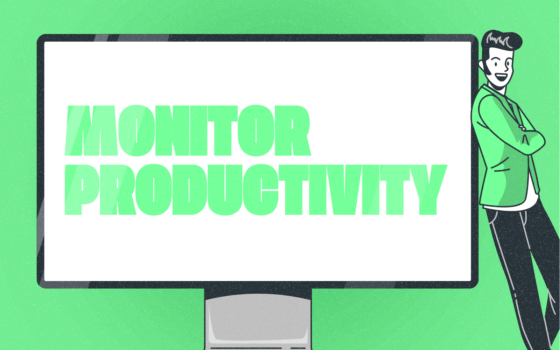How to Deal with a Micromanaging Boss

Imagine being under a microscope at work every day. That’s the reality for many when they have a micromanaging boss.
The constant scrutiny can be suffocating. But don’t despair. You can regain your professional freedom.
With our guide, you’ll learn to set boundaries and communicate effectively. Imagine a workday without undue pressure. You’ll get that when you prove your worth to your boss. It’s not just about surviving but thriving in your workplace.
With the right strategies, dealing with a micromanaging boss becomes an opportunity for growth.
Get more out of your business
Get the best employee engagement content every week via mailing list
Key Takeaways
- Excessive supervision and control in micromanagement can decrease motivation.
- Strategies for micromanaging bosses should include open communication, demonstrating competence and reliability, setting boundaries and managing expectations, and showing empathy and understanding.
- Employees should be aware of signs of an unhealthy work environment and seek help or consider leaving when necessary to maintain mental well-being.
Understanding Micromanagement

““#MicroManaging is a trap #executives must avoid. Doing everything may mean accomplishing nothing.” JMV Ventures.
Micromanagement is a management style in which bosses closely observe and control their employees’ activities.
Dealing with a micromanaging boss can alleviate frustration, decrease motivation, and reduce high turnover rates in the workplace.
Many managers may unknowingly exhibit micromanaging tendencies, as their desire to help their team members succeed can lead to excessive involvement. However, this approach often results in unnecessary stress and negatively affects the company culture.
Definition of micromanagement
Micromanagement is characterized by:
- Excessive supervision and control over employees
- Impeding their autonomy and creativity
- Employees feel suffocated under constant scrutiny.
- Dissatisfaction and lack of motivation result.
Recognizing and understanding micromanagement is the first step toward addressing the issue and fostering a healthier work environment.
Common traits of micromanaging bosses
Micromanaging bosses often exhibit traits such as difficulty delegating tasks, an overemphasis on minor details, and reluctance to trust employees. This management style, which can be considered a restrictive leadership style, can hinder independent decision-making and foster a stifling work environment, negatively impacting the employees’ work style.
Moreover, micromanagers may inadvertently damage team dynamics by focusing too much on the small stuff and losing sight of the bigger picture.
As a result, employees, including other team members, may feel undervalued and demotivated, leading to decreased productivity and heightened stress levels.
Reasons Behind Micromanagement

Micromanagement can stem from insecurity, control issues, lack of employee trust, and high expectations for perfection.
The underlying causes of micromanagement must be understood to tackle the issue and enhance the working relationship with a challenging superior.
Insecurity and control issues
Insecure bosses may micromanage due to a need for control and fear of failure. This desire for control may manifest in excessive involvement in every aspect of a project, which can make employees feel undervalued and demotivated.
Addressing these insecurities may help employees diffuse micromanagement tendencies and cultivate a healthier work atmosphere.
Lack of trust in employees
Micromanagers often distrust their employees, leading to excessive supervision and control. This lack of trust can prevent employees from taking the initiative and being creative, ultimately hindering their growth and success within the company.
Building trust and open communication between employees, micromanaging bosses, and encouraging productive conversation promotes a healthier and more productive work environment.
High expectations and perfectionism

High expectations and perfectionism can drive bosses to micromanage, expecting employees to meet unrealistic standards. This can result in an unhealthy focus on minor details, causing the manager and employees to lose sight of a project’s overall goals and objectives.
It is vital to establish realistic objectives and expectations while offering guidance and support to help employees accomplish these goals to balance high expectations and avoid excessive expectations. Rewarding employees can create a positive and motivating work environment.
Identifying Signs of a Micromanaging Boss

Awareness of the signs of a micromanaging boss can help employees recognize and address the issue. Common indications of micromanagement include excessive supervision, overemphasis on minor details, and resistance to delegating tasks.
Once these signs are recognized, employees can act preemptively to tackle the issue and enhance their work relationship with their superiors.
Excessive supervision
Excessive supervision, such as constant check-ins and updates, is a common sign of micromanagement. This type of supervision can stifle employees and undermine their ability to work independently and efficiently.
Tackling the excessive supervision is key to upholding a healthy and efficient work atmosphere.
Overemphasis on minor details
Micromanagers often focus on minor details, neglecting the bigger picture and overall goals. This can lead to a tunnel-vision approach to projects, causing the manager and employees to lose sight of the primary objectives.
Resolving the problem of overfocusing on trivial details can help maintain the team’s focus on the big picture, fostering more effective collaboration.
Resistance to delegating tasks
Resistance to delegating tasks and allowing employees autonomy is another sign of a micromanaging boss. Micromanagers may be reluctant to delegate tasks due to the following:
- Apprehension of failure
- Desire to maintain control
- Envy or apprehension
- Preference to perform tasks personally
- Lack of confidence in their employees
Tackling the reluctance to delegate is crucial for nurturing a healthy work atmosphere, granting employees the independence and creativity to work independently.
Employees can reduce resistance and create a positive and productive work environment by building trust and open communication with their boss.
Strategies for Handling a Micromanaging Boss

Implementing strategies to handle a micromanaging boss can improve the working relationship and overall job satisfaction. Addressing the root causes of micromanagement and cultivating a positive work relationship can help employees mitigate the adverse effects of micromanagement in their daily work.
Open communication
Open communication with the boss about micromanagement concerns can lead to better understanding and potential solutions. By engaging in open dialogue and discussing the impact of micromanagement on the team’s performance and morale, employees can help their boss gain insight into the issue and work together to address it.
Regular check-ins and updates can also help build trust and open communication with the micromanaging boss. By proactively communicating progress and potential issues, employees can demonstrate competence and reliability, reducing the need for excessive supervision.
Alongside open communication, employees must be open to feedback and prepared to modify their expectations when needed. This can improve the work environment and prevent future micromanagement.
Demonstrating competence and reliability
Demonstrating competence and reliability can help build trust and reduce the need for micromanagement. By meeting deadlines, adhering to instructions, and displaying initiative, employees can prove to their bosses that they can handle tasks independently.
In addition to showcasing competence and management skills, employees should be proactive in problem-solving and assume responsibility for tasks. This can help alleviate the micromanaging boss’s concerns and foster a more positive working relationship.
By consistently delivering results and exhibiting assurance, employees can help their micromanaging boss feel more confident in their team’s abilities, ultimately reducing micromanagement tendencies and fostering a healthier work environment.
Setting boundaries and managing expectations
Setting boundaries and managing expectations can help employees maintain autonomy and reduce micromanagement. Employees can ensure their boss’s expectations are realistic and achievable by being explicit about their capabilities and limitations.
Furthermore, establishing communication and task delegation boundaries can help create a more balanced and productive working relationship. By clearly articulating their needs and expectations, employees can work more effectively with their micromanaging boss and create a healthier work environment.
Developing a Positive Working Relationship

Developing a positive working relationship with a micromanaging boss involves empathy, collaboration, and fostering trust. Employees should address the root causes of micromanagement and collaborate to find solutions.
Empathy is key to understanding why a boss may be micromanaging, as it helps employees feel involved in the process.
Showing empathy and understanding
Showing empathy and understanding towards the boss’s concerns can help address the root causes of micromanagement.
Employees can demonstrate empathy and understanding by listening to their concerns, being patient, and providing solutions to their problems, fostering a more positive working relationship.
Understanding the underlying causes of micromanagement can also help employees tailor their approach to their boss’s needs, ensuring a more effective and collaborative working relationship.
Collaborating on solutions
Collaborating on solutions and working together to improve the situation can lead to a healthier working relationship. By engaging in open communication, task delegation, and fostering trust, employees can work with their micromanaging boss to find effective solutions.
Working together to establish clear expectations and goals can also help reduce micromanagement tendencies. By creating a collaborative environment, employees and their bosses can focus on achieving common objectives and improving overall productivity.
Fostering trust and open communication
Fostering trust and open communication between the employee and boss can help reduce micromanagement tendencies. By being honest and transparent with their boss, employees can create an atmosphere of trust, allowing for more open communication and collaboration.
Additionally, being receptive to feedback and respecting management’s decisions can help cultivate a more positive and trusting working relationship. This can ultimately lead to reduced micromanagement and a healthier work environment.
When to Seek Help or Consider Leaving

Identifying when to seek assistance or contemplate leaving a job with a micromanaging superior is vital for preserving mental well-being and job contentment. By identifying the signs of an unhealthy work environment and seeking support when necessary, employees can protect their well-being and ensure a more fulfilling career.
Identifying signs of an unhealthy work environment
Identifying signs of an unhealthy work environment, such as constant stress and lack of support, can signal the need for intervention or a job change. When micromanagement becomes a persistent issue that negatively impacts employees’ mental health and productivity, it may be time to consider seeking help or exploring other career options.
Understanding the signs of an unhealthy work environment can empower employees to take action and seek help when necessary, ultimately leading to a more positive and productive work life.
Seeking support from HR or higher-ups
Seeking support from HR or higher-ups can help address micromanagement issues and provide guidance on potential solutions. Employees can gain insight into the issue by discussing their concerns with HR or their boss’s boss and working together to address it.
Apart from seeking help, employees should also be open to feedback and ready to adjust their expectations as required.
Employees can work efficiently and reduce the likelihood of micromanagement reoccurring in the future, fostering a more positive work environment.
Considering other career options
Considering other career options, such as finding a new job or starting a business, can provide an escape from a micromanaging boss and increase job satisfaction. Employees should research potential employers, update their resumes, and prepare for interviews to ensure a smooth transition to a new job.
Alternatively, employees may start their own business, allowing them greater control over their work environment and the opportunity to cultivate a more positive and supportive company culture. Ultimately, considering other career options can empower employees to take control of their work lives and escape the negative impact of micromanagement.
Summary
In conclusion, dealing with a micromanaging boss can be challenging. Still, by understanding the causes of micromanagement and employing effective strategies, employees can improve their working relationships and overall job satisfaction. Open communication, demonstrating competence and reliability, and setting boundaries are all crucial aspects of managing a micromanaging boss.
Don’t let a micromanaging boss hold you back from achieving your full potential. Take control of your work life, foster a positive working relationship, and maintain your mental health by recognizing the signs of micromanagement and seeking help when necessary. Remember, you can create a healthier and more productive work environment.
Frequently Asked Questions
What does it mean when your boss micromanages you?
Micromanagement is when managers excessively monitor and control their employees’ work and decision-making, harming a healthy working relationship. Many people have experienced it in their careers.
How do you deal with a boss that is micromanaging?
Practice empathy by understanding your boss’s point of view, express concerns calmly and clearly, and discuss roles and responsibilities if necessary. Establish trust, open up dialogue about the situation, and keep communication open to mitigate micromanaging.
How can I stop my boss from micromanaging me?
Communicate openly with your boss about their micromanaging tendencies, provide alternatives that could be more effective, and demonstrate your capability to complete tasks without close supervision. Respectfully ask your boss to trust your abilities and allow you the autonomy to complete your work.
How can I address my micromanaging boss?
Openly communicate with your boss, show them you are reliable and competent, manage expectations, and set boundaries to address micromanagement.


